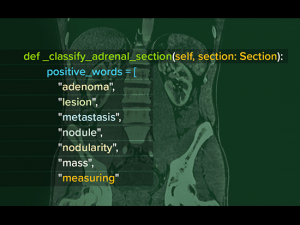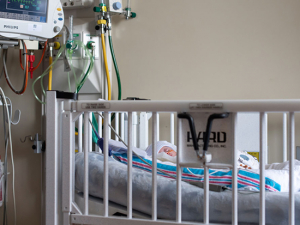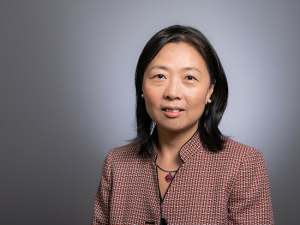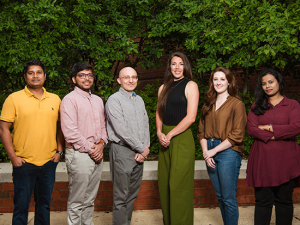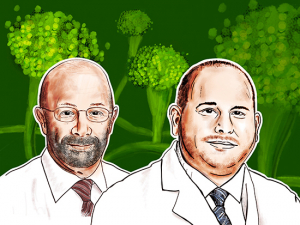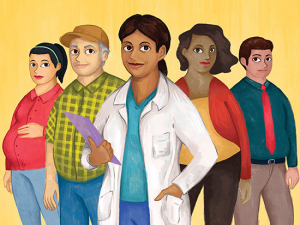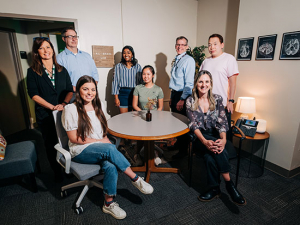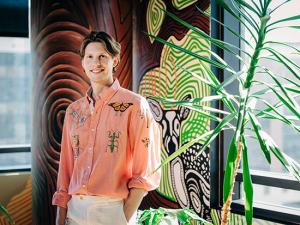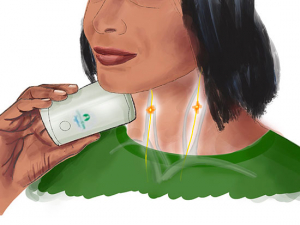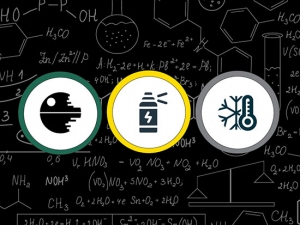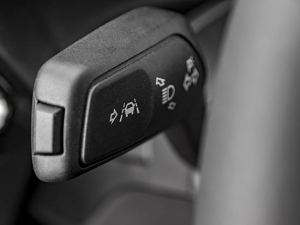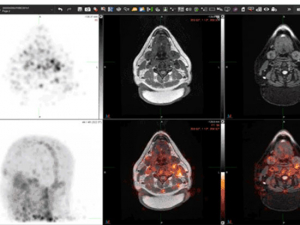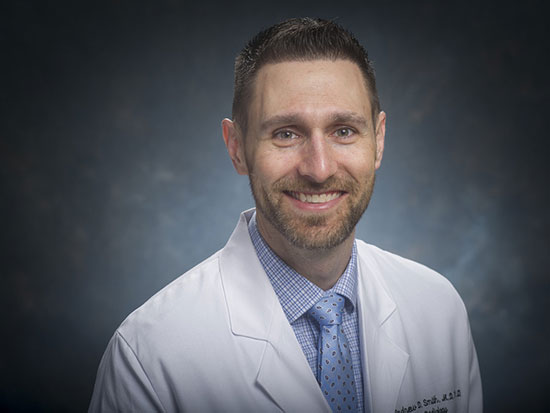 Andrew Smith, M.D., Ph.D., is founder and CEO of the UAB spinoff company AI Metrics and co-director of entrepreneurship in the Department of Radiology. Smith helps lead the department's quarterly Entrepreneurship Rounds.One of the main objectives of Forging the Future, UAB's strategic plan, is to “enhance UAB's institutional culture of collaboration and innovation” by creating “an environment and opportunities that facilitate collaboration and foster innovation.”
Andrew Smith, M.D., Ph.D., is founder and CEO of the UAB spinoff company AI Metrics and co-director of entrepreneurship in the Department of Radiology. Smith helps lead the department's quarterly Entrepreneurship Rounds.One of the main objectives of Forging the Future, UAB's strategic plan, is to “enhance UAB's institutional culture of collaboration and innovation” by creating “an environment and opportunities that facilitate collaboration and foster innovation.”
The key word is “create” — underscoring the fact that innovation is a matter of attitude and actions rather than something in the way a person is wired.
“An entrepreneurial mindset must be developed," said Cheri Canon, M.D., chair, professor and Witten-Stanley Endowed Chair of Radiology. "Everyone can have good ideas. It's a matter of honing the way you view problems."
Stimulate discussion, offer guidance
Canon is explaining the reason she instituted Radiology’s Quarterly Entrepreneurship Rounds, which are open to all faculty, staff and residents in the department. "Different faculty members have varying experience with entrepreneurial development," Canon said. "I don’t innately have that mindset myself. My role as chair is to cultivate this in my faculty and provide the resources and support for their success. I wanted to stimulate discussion around ideas and have those with more experience mentor the others — have them share their successes and failures."
The entrepreneurship rounds are co-led by radiology faculty (and co-directors of entrepreneurship in the department) Andrew Smith, M.D., Ph.D., and Srini Tridandapani, Ph.D., M.D. "We both have experience with inventions, patents, startup companies, small business grants and more," said Smith, who is an associate professor and vice chair of Clinical Research in the department. "We both run our own startup companies, and we provide guidance to faculty and staff in radiology who have innovative ideas."
Smith also serves on the UAB Entrepreneurial Development Committee, developed by the UAB Harbert Institute for Innovation and Entrepreneurship (HIIE). The committee works with startup companies in their early stages to help them create and implement development plans outlining appropriate use and allocation of UAB facilities and resources.
Challenge yourself
In the near future, the rounds will include a challenge to develop an elevator pitch for a new idea, which participants will refine into a single-page business plan and then progress to a full commercialization plan. "The concept of Entrepreneurship Rounds has been replicated and modified by other groups at UAB," Smith said.
Smith credits the HIIE with helping him launch his startup AI Metrics in 2019. In late May 2020, Smith delivered a virtual talk at the American Society of Clinical Oncology annual meeting, highlighting the results of a multi-institution trial of an AI Metrics-developed software tool to assist radiologists in accurately identifying tumor response to treatment in patients with solid cancers. The AI Mass tool increased accuracy by 25%, reduced major errors by 99% and was nearly two times faster than traditional methods of tumor measurement and response classification.
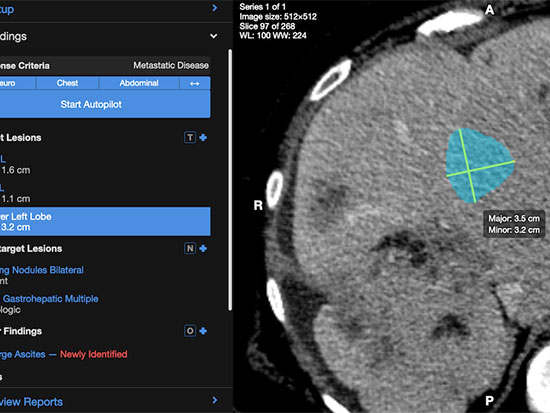 A screenshot from the AI Metrics platform. At the annual conference of the American Society of Clinical Oncology in May, Smith presented results of a multi-institution study that found that human-guided artificial intelligence software improved accuracy and doubled speed in evaluating CT scans of advanced cancer.Smith’s work was featured by the well-known radiology website AuntMinnie and earned him an Imaging Innovator award from the Academy of Radiology and Biomedical Imaging Research. The ASCO presentation also opened the doors to demonstration appointments with four academic institutions, and "we also had a technology startup company contact us and arrange a teleconference to consider us for a major lung-cancer initiative in Europe," Smith said.
A screenshot from the AI Metrics platform. At the annual conference of the American Society of Clinical Oncology in May, Smith presented results of a multi-institution study that found that human-guided artificial intelligence software improved accuracy and doubled speed in evaluating CT scans of advanced cancer.Smith’s work was featured by the well-known radiology website AuntMinnie and earned him an Imaging Innovator award from the Academy of Radiology and Biomedical Imaging Research. The ASCO presentation also opened the doors to demonstration appointments with four academic institutions, and "we also had a technology startup company contact us and arrange a teleconference to consider us for a major lung-cancer initiative in Europe," Smith said.
Smith has other innovations in the percolator as well. "One of my recent ideas was to measure the irregularity at the surface of the lungs to assess the severity of pulmonary fibrosis, which often pulls the lung surface inward but in an irregular fashion," Smith said. He refers to this measurement as the pulmonary surface index, or PSI. "We have some outstanding preliminary results and are pursuing a patent and further commercialization."
Innovation in action
“The Department of Radiology has a number of innovators," Smith said:
- Srini Tridandapani, co-director of entrepreneurship, who has patents in a new form of cardiac CT that uses ultrasound instead of EKG to time the scan. He is the founder of the startup Camerad Technologies, which is commercializing a method of incorporating point-of-care photography in medical imaging to detect wrong-patients errors, wrong location errors and provide clinical context for radiologists.
- Ben Larimer, Ph.D., who holds several patents pertaining to new PET imaging agents that can be used to predict and monitor response to cancer therapy. Two of these patents have been licensed and he has a first-in-human trial now ongoing at UAB.
- Harrison Kim, Ph.D., who is the inventor of a point-of-care MRI perfusion phantom, a simulation that is used to correct errors in measuring perfusion parameters in various organs.
- David Gauntt, Ph.D., a medical physicist who has developed a quality-assurance tool for CT scanners that is being licensed to a company that will further commercialize it.
“Clinical imaging is a hotbed of innovation,” Canon said. “Just look at the technology that is being developed.”
‘Get the HIIE involved early’
What advice does Smith have for faculty, staff or students who want to turn their ideas into companies or licenses?
"Talk to someone who is experienced," Smith said. "I have clinicians and researchers from different groups talking to me, and I talk to others with substantial experience. There is a lot to consider and many different options for moving an innovative idea forward."
But his most important piece of advice is "to get the HIIE involved early," Smith said. "They are here to help and have provided me and many others with good advice."
Educating faculty about intellectual property and commercialization is an important part of his job, said Karthik Gopalakrishnan, Ph.D., director of licensing and new ventures at the HIIE. “Our staff will help you understand the commercial potential and the market trends related to your invention,” Gopalakrishnan said.
Where to begin
The first step in working with the Harbert Institute is to complete the Intellectual Property Disclosure (IPD) form at uab.edu/innovation/disclose. Even if an investigator thinks there is nothing particularly novel in an idea or finding, it’s best to reach out to Gopalakrishnan and his team for a quick chat, he said.
“Please speak with us about a potential invention before you publish or present it to the world,” Gopalakrishnan said. “Once research has been published or presented in a public forum, the ability to protect the intellectual property is significantly reduced or lost altogether. That is unfortunate for UAB, the inventor and perhaps more important, the people who would have benefitted from that invention.”
"We routinely submit invention disclosures to the Harbert Institute and some have led to new patents,” Smith said.
In 2019, HIIE received 90 intellectual property disclosures, executed 37 licenses and had 15 U.S. patents issued. Licensing revenue was $6.43 million, up nearly 38% since 2017.
“If we are successful in licensing an invention, it starts a virtuous cycle,” Gopalakrishnan said. “Research leads to invention disclosures, which lead to licensing, commercialization and royalties, which go back to fund research.”

